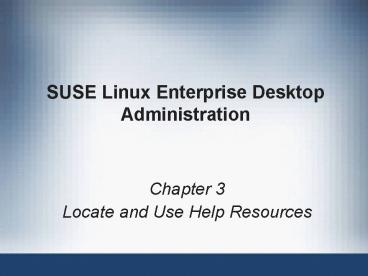SUSE Linux Enterprise Desktop Administration - PowerPoint PPT Presentation
1 / 25
Title:
SUSE Linux Enterprise Desktop Administration
Description:
Objective 1 Access and Use man Pages. Objective 2 Use info Pages ... If you prefer HTML, an HTML version is available in the manual/subfolder. 18 ... – PowerPoint PPT presentation
Number of Views:62
Avg rating:3.0/5.0
Title: SUSE Linux Enterprise Desktop Administration
1
SUSE Linux Enterprise Desktop Administration
- Chapter 3
- Locate and Use Help Resources
2
Objectives
- Objective 1Access and Use man Pages
- Objective 2Use info Pages
- Objective 3Access Release Notes and White Papers
- Objective 4Use GUI-Based Help
- Objective 5Find Help on the Web
3
Objective 1Access and Use man Pages
- man command
- The most important command for online help
- All manual pages are available in English
- And many have been translated into other
languages - To display the English version of the man page
for the man command - LANGen_EN man man
4
Objective 1Access and Use man Pages (continued)
- The first page of the manual pages
5
Objective 1Access and Use man Pages (continued)
- Parts of a manual page
Table 3-1 Parts of a manual page
6
Objective 1Access and Use man Pages (continued)
- The program man uses the program less to display
the manual pages - Within less, the display of text is controlled by
the keys shown in Table 3-2 - The manual pages are organized in the sections
shown in Table 3-3 - It is especially important to know to which
section a command belongs - When the command has more than one manual page
7
Table 3-2 less command keys
8
Objective 1Access and Use man Pages (continued)
Table 3-3 Sections in manual pages
9
Objective 1Access and Use man Pages (continued)
- You can display a brief description of all the
available manual pages for a command or utility - By using the whatis command
- Manual pages are located in the directory
/usr/share/man/
10
Exercise 3-1 Access and Use man Pages
- In this exercise, use the whatis and man commands
to get information on the info command - In the manual page, look for filename
11
Objective 2Use info Pages
- A whole series of programs are no longer provided
with manual pages - Instead, info files are used, which can be read
with the info command - info files are located in the directory
/usr/share/info/ - Advantages of the info file format
- It uses a structured document setup
- Specific sections can be reached directly from
the table of contents - Specific sections can be linked
12
Objective 2Use info Pages (continued)
- The beginning of the info file for the info
command
13
Table 3-4 Most commonly used key commands for the
info command
14
Exercise 3-2 Access and Use info Pages
- In this exercise, use the info command to get
information on info and navigate through the info
text
15
Objective 3Access Release Notes and White Papers
- Release notes, white papers, and other sources of
helpful information - Stored in the directory /usr/share/doc/
- This directory contains the following
- Release Notes
- Manuals
- Help for Installed Packages
- HOWTOs
16
Release Notes
- When you complete the installation of SUSE Linux
Enterprise Server - The release notes appear in a window
- See Figure 3-1
- You can find them in various languages in the
directory /usr/share/doc/release-notes/SUSE_Linux
Enterprise_Desktop__10/
17
Figure 3-1 SUSE Linux Enterprise Desktop release
notes
18
Manuals
- A PDF version of the manual is in
/usr/share/doc/manual/sled deployment_en/ - If you prefer HTML, an HTML version is available
in the manual/subfolder
19
Help for Installed Packages
- Help files are available in the following
directory for most installed packages - /usr/share/doc/packages/package-name/
- These help files are written by the programmers
of the package - Therefore, the format of these files is not
standardized
20
HOWTOs
- You can find additional information (including
background material) in the howtos - A howto is available for almost every imaginable
topic in Linux - You can find a list of all current howtos at
www.tldp.org
21
Objective 4Use GUI-Based Help
- An online help tool is available for graphical
applications - See Figure 3-2
- To start the online help, select Computer gt More
Applications gt System gt Yelp - Use the links to navigate through the content
- You also can use the search function to speed up
your search for help - The online help is available in most GNOME
applications and can be started by pressing F1
22
Figure 3-2 GUI-based help
23
Objective 5Find Help on the Web
- Some of the more frequently used Linux sites
- www.novell.com/linux
- www.tldp.org
- www.cert.org (especially for security issues)
- www.securityfocus.com (especially for security
issues) - www.kernel.org (especially for issues in
connection with the Linux kernel) - www.novell.com/coolsolutions/ (follow the links
on Linux)
24
Exercise 3-3 Access Release Notes and Find Help
on the Web
- In this exercise, you access release notes and
find help on the Web - Use the Nautilus file manager to access the
release notes in /usr/share/doc/releasenotes/ - Start Firefox and access the Linux Documentation
Project at www.tldp.org - Look for updates for SUSE Linux Enterprise
Desktop 10 on the Novell support Web site - Then, use the Google Linux search engine to find
information on GNOME and SLED10 in the Internet
25
Summary
- There are several help resources available
locally on your SUSE Linux system as well as on
the Internet - The manual pages contain the syntax and usage of
most commands and files on your system - The info pages are an alternative to the man
pages that format information differently and can
contain links to other sections - The /usr/share/doc directory contains the manual
and release notes for the SUSE Linux installation































